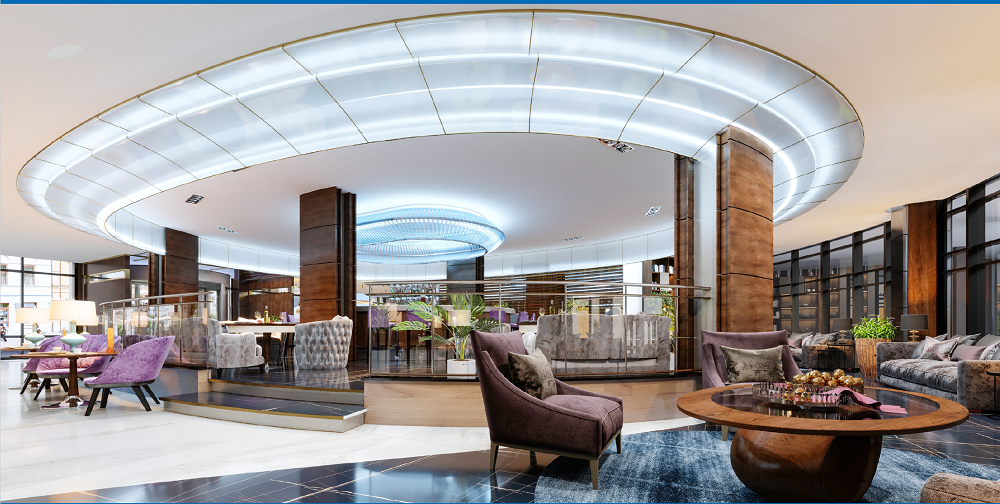AV professionals have many options when selecting loudspeakers for a project. From the size, style, price and brand, project teams choose and install systems and components based on experience with the technology and its performance over time, among other things. While there are many loudspeaker form factors to choose from, such as line arrays or column loudspeakers, point-source loudspeakers are a very popular choice for several reasons. Understanding some of the science behind point-source technology can help integrators understand the best applications for the speakers and create happier clients.
Understanding ‘Point Source’
The term ‘point source’ originates from mathematics and physics and is described as a singular point in space, small in dimension, where energy (in this case, sound waves) originates. When the energy radiates from the point source, it creates uniform sound waves that move equally in all directions, independent of frequency.
A point-source loudspeaker generally comprises a single loudspeaker enclosure, driven by a single source. True point-source loudspeakers place the tweeter in the center of the woofer (as opposed to centrally mounting the tweeter in front of the woofer), ensuring that sound waves emitted by the tweeter and woofer are time aligned and reach the listener’s ears at the same time and from the same direction. They create a wider sweet spot with a more natural and coherent sound, closer to how we experience sound in real life.
A point-source loudspeaker maintains a symmetrical dispersion horizontally and vertically but also phase coherence throughout the frequency band, including the critical crossover region to the low-frequency woofer. In addition, the high efficiency of the tweeter reduces power compression to give an exceptional transient response. Point-source loudspeakers can take many forms, the most popular being in-ceiling, surface mount and pendent.
Applicable Spaces
With any audio-installation project, a space’s size, acoustic properties and the client’s needs determine the types of loudspeakers to recommend. For instance, will the system’s primary function be to deliver spoken words or music, either background or foreground music? Or a combination of all of them? In any case, frequency response, positioning and dispersion pattern are critical. Also, the loudspeaker must be able to deliver the required SPL appropriate for the room size and application.
Before making loudspeaker recommendations, there’s considerable value in acoustically modeling the room or space via certain software. It allows designers and acousticians to place loudspeakers virtually and determine the optimal layout for the most consistent coverage. Integrators are often surprised by how few point-source loudspeakers are needed to provide adequate room coverage.
Here are some some common applications to consider for point source loudspeakers:
Corporate Boardrooms
A typical boardroom ranges between 200 to 400 square feet with 9- to 12-foot ceilings with hard-surface walls of glass, brick, concrete or drywall. Architects typically don’t want any aspect of AV equipment to “mar” the clean lines they’ve designed, so it’s common to use in-ceiling loudspeakers in this application for minimal intrusion. The symmetrical nature of point source loudspeaker coverage makes them easy to model and predict with naturally occurring even coverage. Often the biggest challenge is taking into account the placement of the loudspeakers in relation to the HVAC vents and lights, and possibly ceiling microphones.
Houses of Worship
Square footage of houses of worship can vary greatly, often in relation to the congregation’s size. The sanctuary’s ceilings are often elevated or sloped, ranging from 20 to 60 feet high. Traditional houses of worship are renowned for being highly reverberant, given the architecture and building materials. Compared to traditional facilities, contemporary worship facilities usually have better but still not excellent acoustics. Integrators should again evaluate the interior materials’ sound reflections and absorption qualities and whether it’s permissible to install sound absorption materials of some form (even wall hangings will help).
Download: 2023 House of Worship Deep Dive Report
Depending on the sanctuary size, line arrays, column or point-source loudspeakers will often flank the sides of the nave. For larger churches that utilize line arrays, point source-loudspeakers are a great choice as fill loudspeakers for the congregation.
Restaurants
Restaurants use audio systems for background music and paging announcements. Often small to midsize spaces with multiple rooms or zones, most restaurant spaces have unique architectural footprints and layouts. Fewer point-source loudspeakers are needed to adequately cover most spaces in a restaurant, given their dispersion patterns. Integrators can install point-source loudspeakers in open ceilings above guests (typically a pendent or surface-mount loudspeaker, depending on the restaurant’s desired atmosphere), providing widespread coverage or smaller, more intimate cones of sound as desired by the end user.
Open ceiling spaces are festooned with HVAC ducts, sprinklers and other structural members that obstruct sound, so installers can again benefit from acoustically mapping the room first for proper loudspeaker coverage. Ambient noise fluctuation is another factor to consider in people-intensive spaces like restaurants. While a point-source loudspeaker will provide excellent horizontal and vertical coverage with more natural and intelligible sound, background music may sometimes be difficult to hear as the number of patrons increases. Audio systems with automatic gain control (AGC) capabilities are beneficial in any establishment where room noise varies.
Point-source loudspeakers are among the most versatile on the market and can be used in most projects. For some applications, integrators may need to use them to complement other loudspeakers and can easily blend them into the background architecture. Their symmetrical dispersion patterns can benefit an installation by reducing the number of loudspeakers required for adequate room coverage, saving a client money on hardware and installation time.
After evaluating the audio challenges within a room, point-source loudspeakers can be an excellent choice to create cohesive and high-quality sound coverage and clarity, even for those on a limited budget.
Mike Ulrich is vice president of Specialty Acoustic Projects, AtlasIED.




